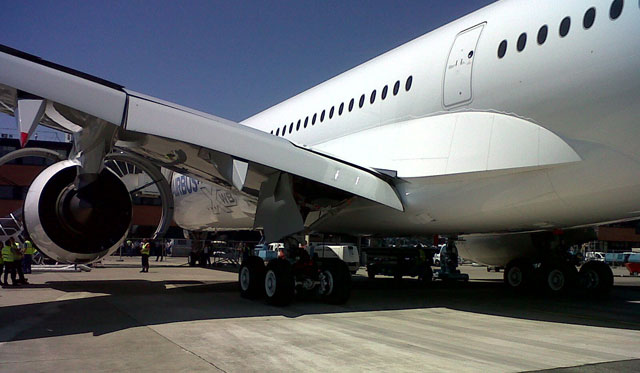Airbus has outlined the initial test regime likely to be flown by the A350-900 when it performs its maiden flight from Toulouse.
Configured at a medium centre of gravity and medium weight, the aircraft will be flown off the runway in direct law, with flight-control computers disconnected.
The aircraft will probably be taken to around 10,000ft (3,050m) for the initial part of the test, travelling at an airspeed of around 200kt (370km/h).
 |
|---|
Project test pilot for the A350 programme Frank Chapman says the Airbus procedure is "slightly different" to Boeing's.
Once the crew is satisfied and confident with the manner in which the aircraft handles, he says, they will typically undertake configuration changes with flaps.
This will then lead to gear retraction. Telemetry data will be supplemented with information from chase aircraft.
The pilots will engage normal flight-control laws and "push the speeds up" to the higher end of the normal operating range at around 25,000ft, says Chapman, testing the aeroelastic response of the aircraft "to see if it matches predictions".
Further tests at higher Mach numbers could then take place at 43,000ft - the aircraft's highest cruising altitude. Flight-test engineer Pascal Verneau suggests that, if the A350 is performing without problems, the airspeed could be increased to around M0.89.
Chapman says that approach configurations would be checked and the aircraft would conduct a fly-by about 1,000ft above the runway before positioning for landing.
All six crew will carry parachutes as a precaution. In an emergency the crew would move from the cockpit into the forward cabin, and exit via a hatch in the floor.
"Any time we go to places [in the flight envelope] we haven't been before, we have to wear a parachute," says Chapman.
 |
|---|
Unlike previous escape systems on test aircraft, based on pyrotechnics, the A350's features a centre section of the forward cargo door, on the right of the fuselage, which can be unlocked and jettisoned electronically.
The maiden flight would occur after the aircraft has undertaken high-speed taxiing runs - around 120kt - but Chapman says the weather conditions will be crucial.
Although a cloud base of 1,500ft and 3km visibility would be adequate, thunderstorms would be the "biggest problem" given the limitations of the aircraft at the early stage of the test regime. "We don't want to get struck by lightning," Chapman says.
After the first flight the airframer will spend a day thoroughly examining the aircraft on the ground, to ensure that none of its systems have suffered any adverse effects.
Airbus is aiming to certificate the A350-900 just over a year from first flight, supported by some 2,500h of flight time. The effort will be accelerated by the decision to use five aircraft in the flight-test fleet, and to frontload much of the developmental testing in the operational environment.
Delivery will take place in the second half of 2014, says Chapman, "provided we have no major surprises along the way". He says the clearance of the Rolls-Royce Trent XWB means Airbus has "one less concern".
"It's often said that if an aircraft looks right, it'll fly right," says Chapman. "And, boy, this aircraft looks right."
| More on the A350 programme is exclusively available to read for FG Club members.
(n.b. Pro users can sign into the FG Club with their existing details) |
Source: Air Transport Intelligence news



















